Firearms Technical Trivia, March 2000:
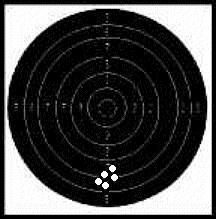 |
 |
 |
Open the pages of any slick, glossy gun magazine and you will see glowing reports about the latest advances in sight technology. You can now buy sights for your rifles and pistols that are laser powered, nitrogen cooled, heat seeking, rangfinding, distance compensating, and indeed, do everything for you with the possible exception of cleaning the firearm after you're done shooting. Yet, the overwhelming majority of firearms, both domestically and abroad, can be found with sights that hark back to, and indeed, that have changed little since, the middle of the 19th century. Why? The answer is simple - they work well, are inexpensive, simple to use, and durable. The only problem arising with fixed or "iron" (Glock pistols notwithstanding) sights, is the confusion over what the proper sight picture looks like, and how to properly adjust the sights to center the shot group. We're going to go back to basics, and discuss these issues at length.
Looking
at a pistol, one immediately notices that there are two sighting components,
the rear sight and the front sight. One of the keys to accurate shooting
is understanding the correct relationship between the front and rear sights.
When aiming, the front sight should be positioned in the middle of the
rear sight notch with an equal light space on each side. The horizontal
top surface of the front sight should be on the same level as the top horizontal
surface of the rear sight notch. The proper relationship between
front and rear sights is illustrated below:

Image Credit: http://ourworld.compuserve.com/homepages/Dreyer_infonet/chapter2.htm |
Now, if the correct sight picture (maintaining the top surface of the centered front sight on a level with the top of the rear sight and equal light space on each side of the front sight) is not maintainted, you, the shooter, are very |
simply
not going to hit what you're aiming at. Among the most common sight
alignment errors is locating the front sight in a different position inside
the rear notch. This will result in a dispersion of the shots on the target,
since the bullets will tend to strike in the direction in which the front
sight is positioned in the notch. The results of this aiming error,
known as "Angular Shift Error" are illustrated below:

Image Credit: http://ourworld.compuserve.com/homepages/Dreyer_infonet/chapter2.htm |
Now that
we know what the sights are supposed to look like in relation to one another,
let's explore what the sights should look like when you hold the firearm
on target. First off, this is what they should NOT look like:
| The issue is more of that a proper sight picture cannot look like the image on the right. This is because the human eye cannot focus on near and far objects simultaneously. There are three possible points of focus when the gun is on target and the sights are properly aligned. These are the front sight, the rear sight, and the target itself. Of these three, |
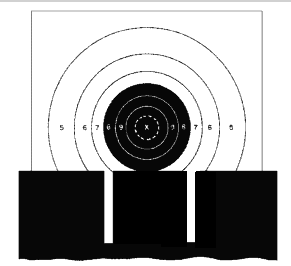
Image Credit: http://ourworld.compuserve.com/homepages/Dreyer_infonet/chapter2.htm |
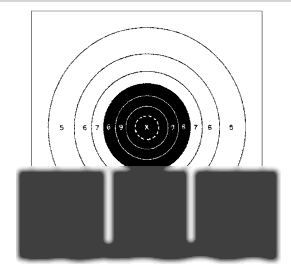
Image Credit: http://ourworld.compuserve.com/homepages/Dreyer_infonet/chapter2.htm |
the one to focus on is the front sight. An incorrect sight picture is illustrated to the left. In this image, the shooter has focused on the target, and not the front sight. By focusing on the target, the shooter loses the ability to maintain precise control of the sights alignment. In other words, distinct focus on target renders sight indistinct. Properly limiting |
| focus to the front sight only, renders the sights distinct and target indistinct and enables sight relationship to be consistently controlled. An additional benefit to limiting focus to the front sight is that the shooter perceives a smaller arc of motion, and a steadier aim. Whether or not this is actually the case, we'll take every advantage we can get! | 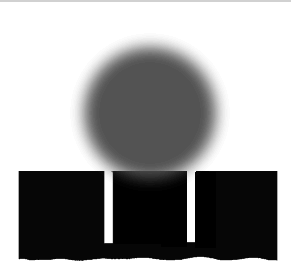
|
Now that we know what the sights are supposed to look like in relation to one another and in relation to the target, and are getting consistent shot groupings, we need to consider how to adjust the sights so that the shot groupings are centered on the target. The secret to adjusting iron sights lies in remembering that the goal of any movement of the sight is to cause the shooter, when a proper sight picture has been attained, to shift the muzzle of the firearm in the desired direction. The objective is to move the sights either vertically or horizontally so as to effect a concomittant horizontal or vertical movement of the muzzle. The "trick" to this is remembering that movement of the front sight and rear sights have different effects on which way the muzzle will move in reaction to sight adjustment. To do so, we use the mnemonic "FORS," which stands for "Front Opposite, Rear Same." This means that to make an adjustment using the front sight, we move it in the OPPOSITE direction from where we want the shot group to move, and if we are using the rear sight to make the adjustment, we move it the SAME direction as we want the shot group to move.
Let's take a look at the various horizontal and vertical shot group placement errors, and discuss their corrections using both the front and rear sights.
Horizontal Error to the Right
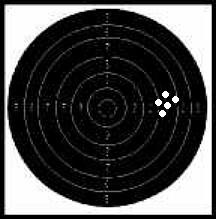 |
This
shot group has impacted to the right of center. Whatever correction
is implemented, the object will be to move the muzzle, and consequently
the shot group, to the left.
Rear Sight Correction: Using the FORS formula, we know that we need to move the rear sight in the direction of the |
Front Sight Correction: The FORS formula indicates that the front sight will need to be moved to the right, in the direction of the error. When the front sight is moved to the right, a condition is created where it, and the muzzle, must be brought to the left to maintain sight alignment.
Horizontal Error to the Left
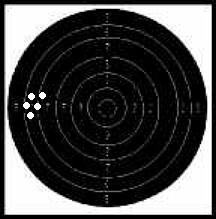 |
This
shot group has impacted to the left of center. The object of the
correction will be to move the muzzle, and consequently the shot group,
to the right.
Rear Sight Correction: Using the FORS formula, we know that we need to move the rear sight in the direction of the |
Front Sight Correction: The FORS formula tells us that the front sight will need to be moved to the left, in the direction of the error. When the front sight is moved to the left, a condition is created where it, and the muzzle, must be brought to the left to maintain sight alignment.
Vertical Error to the Top
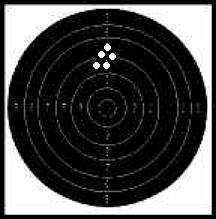 |
This
shot group has impacted above the center of the target. Whatever
correction is implemented, the object will be to move the muzzle, and consequently
the shot group, down.
Rear Sight Correction: Based on FORS formula, we know that we need to move the rear sight in the direction of the |
Front Sight Correction: The FORS formula indicates that the front sight needs to be moved up, in the direction of the error. When the front sight is moved up, a condition is created where it, and the muzzle, must be brought down to maintain sight alignment. Note: Most front sights are not readily adjustable for elevation. Compensating for elevation using the front sight usually requires either replacement of the front sight or physical alteration of the part.
Vertical Error to the Bottom
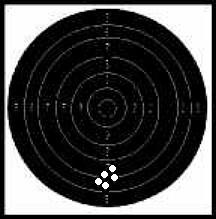 |
This
shot group has impacted below the center of the target. Whatever
correction is implemented, the object will be to move the muzzle, and consequently
the shot group, up.
Rear Sight Correction: Based on FORS formula, we know that we need to move the rear sight in the direction of the |
Front Sight Correction: The FORS formula indicates that the front sight needs to be moved down, in the direction of the error. When the front sight is moved down, a condition is created where it, and the muzzle, must be brought up to maintain sight alignment. Note: Most front sights are not readily adjustable for elevation. Compensating for elevation using the front sight usually requires either replacement of the front sight or physical alteration of the part.
Those
are the basics of using and adjusting your iron sights. They are
simple and easy to use, and we can expect to see them on firearms for years
to come.
Note: Data for this month's trivia page was gathered from:
The
US Army Marksmanship Unit Pistol Marksmanship Training Guide.
Click
on the link to obtain a compressed copy of this publication in Adobe PDF
format.